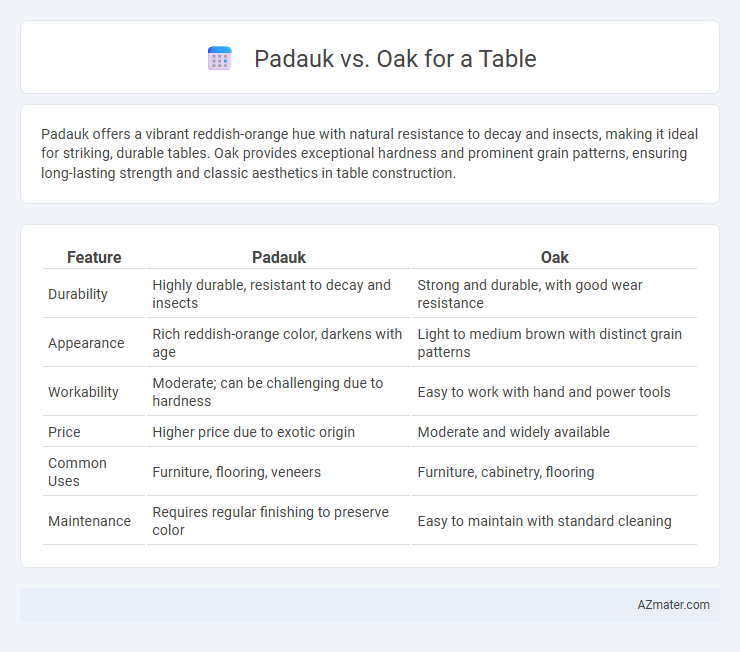Padauk offers a vibrant reddish-orange hue with natural resistance to decay and insects, making it ideal for striking, durable tables. Oak provides exceptional hardness and prominent grain patterns, ensuring long-lasting strength and classic aesthetics in table construction.
Table of Comparison
| Feature | Padauk | Oak |
|---|---|---|
| Durability | Highly durable, resistant to decay and insects | Strong and durable, with good wear resistance |
| Appearance | Rich reddish-orange color, darkens with age | Light to medium brown with distinct grain patterns |
| Workability | Moderate; can be challenging due to hardness | Easy to work with hand and power tools |
| Price | Higher price due to exotic origin | Moderate and widely available |
| Common Uses | Furniture, flooring, veneers | Furniture, cabinetry, flooring |
| Maintenance | Requires regular finishing to preserve color | Easy to maintain with standard cleaning |
Introduction to Padauk and Oak Woods
Padauk wood, prized for its vibrant reddish-orange hue and natural resistance to decay, offers exceptional durability in table construction. Oak wood, known for its prominent grain patterns and high density, provides strength and timeless elegance ideal for heavy-use furniture. Both hardwoods deliver distinct aesthetic and functional benefits that influence their selection for tables.
Padauk vs Oak: Appearance and Color
Padauk showcases a vibrant reddish-orange hue that intensifies over time, creating a striking, warm aesthetic ideal for statement tables. Oak offers a more subdued, natural range from light tan to medium brown with distinct grain patterns, lending a classic and versatile look. The bold, vivid color of Padauk contrasts sharply with Oak's earthy and neutral tones, making each wood distinctly suited to different design preferences.
Durability and Hardness Comparison
Padauk exhibits a Janka hardness rating of approximately 1,710 lbf, making it exceptionally resistant to dents and wear, while White Oak measures around 1,360 lbf, offering good durability but slightly less hardness. The natural oils in Padauk contribute to its superior resistance to decay and insects, enhancing its longevity in furniture applications such as tables. Oak's dense grain structure provides stability and scratch resistance, but Padauk's higher hardness and natural resilience make it a preferred choice for heavy-use surfaces requiring robust durability.
Grain Patterns and Texture Differences
Padauk features vibrant reddish-orange hues with straight to interlocking grain patterns, creating a visually striking and bold appearance ideal for modern tables. Oak displays a more subdued palette ranging from light beige to deep brown, with pronounced, open grain patterns that offer a classic and textured tactile experience. The dense and hard texture of Padauk results in a smoother finish, while Oak's porous surface provides a more rustic and warm feel to tabletops.
Workability: Padauk vs Oak
Padauk wood offers excellent workability due to its straight grain and moderate hardness, allowing for smooth cutting, sanding, and finishing in table construction. Oak, especially white oak, is harder and denser, requiring more effort during machining but provides superior durability and a strong, stable surface. Both woods respond well to sanding and finishing, but Padauk's softer texture makes it more forgiving for intricate detailing compared to oak's robust nature.
Suitability for Tabletops
Padauk offers a striking reddish hue and excellent dimensional stability, making it a popular choice for high-end tabletops requiring visual impact and durability. Oak, known for its strength, distinctive grain patterns, and resistance to wear, is highly suitable for tabletops subjected to heavy use and provides a classic, timeless appearance. Both hardwoods perform well in furniture applications, but Padauk's unique color and smooth finish may appeal more for decorative surfaces, while Oak provides greater longevity and ease of maintenance.
Cost and Availability
Padauk wood tends to be more expensive than oak due to its exotic origin and limited availability, often sourced from Southeast Asia. Oak is widely available in North America and Europe, leading to lower costs and easier procurement for furniture makers. For table construction, oak offers a cost-effective choice with abundant supply, while padauk provides a premium option with distinctive reddish hues but at a higher price point.
Maintenance and Longevity
Padauk wood offers excellent resistance to decay and insects, requiring minimal maintenance to preserve its vibrant reddish-orange color, which may darken over time but can be rejuvenated with light sanding and oiling. Oak, known for its hardness and durability, demands regular sealing or finishing to prevent moisture damage and maintain its classic grain appearance, especially in high-traffic or humid environments. Both woods provide long-lasting performance as table materials, but Padauk's natural oils contribute to easier upkeep, whereas Oak's longevity depends on consistent care and protection from wear.
Sustainability and Environmental Impact
Padauk wood, sourced primarily from West Africa and Southeast Asia, is valued for its rapid growth and ability to regenerate quickly, making it a more sustainable option for table construction compared to traditional oak. Oak, native to temperate regions, tends to have slower growth rates and a higher environmental impact due to longer harvesting cycles and deforestation concerns. Utilizing Padauk can reduce carbon footprints and promote responsible forestry practices, whereas oak's environmental impact varies significantly depending on the certification and sourcing methods employed.
Final Verdict: Choosing Between Padauk and Oak for Tables
Padauk offers a vibrant reddish hue and exceptional durability, making it ideal for statement tables that require both beauty and resilience. Oak provides timeless elegance with its coarse grain and excellent strength, suited for classic, durable furniture pieces in various interior styles. For a balance of aesthetic appeal and long-term stability, Oak is preferred for versatile tables, while Padauk stands out for unique, eye-catching designs.

Infographic: Padauk vs Oak for Table
 azmater.com
azmater.com